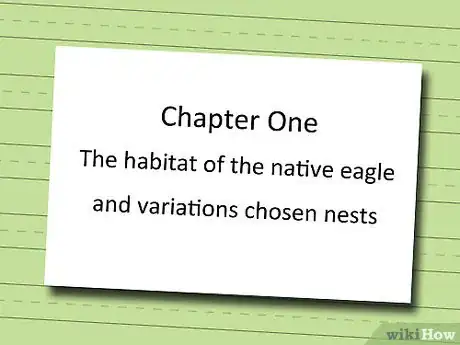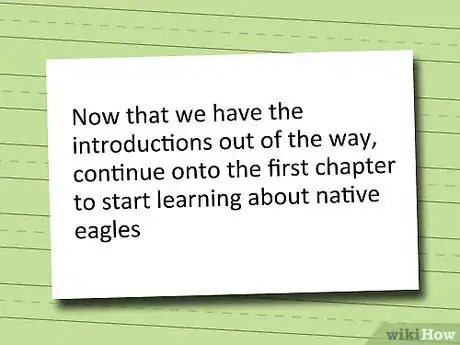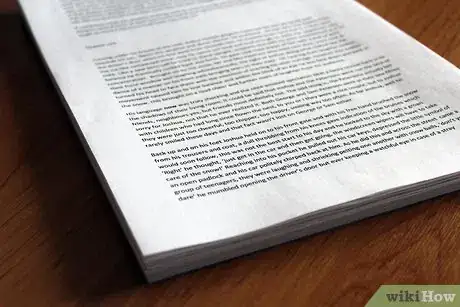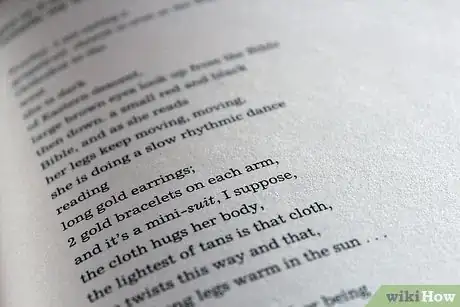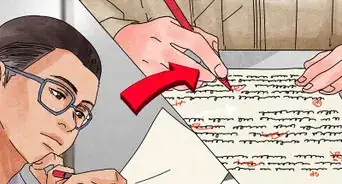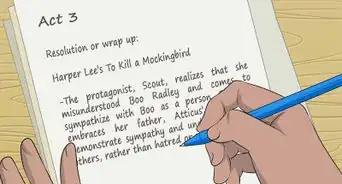wikiHow is a “wiki,” similar to Wikipedia, which means that many of our articles are co-written by multiple authors. To create this article, volunteer authors worked to edit and improve it over time.
This article has been viewed 74,438 times.
Learn more...
Books often have an introduction before the first chapter of the book. This text, which is essentially a short chapter, is meant to provide information on what the book is going to be about. It gives background information, talks about why the book is important and gives an overview of the contents.
Steps
Developing the Introduction
-
1Summarize or outline the book. If you have an outline, pull it out to use in your introduction. If you don’t have an outline, go chapter by chapter and write a short, paragraph-long summary of each chapter as your outline.[1]
- Think about your main ideas as you are writing notes for your introduction. Sketch out the overall themes of your book, so you have them ready.
-
2Start out with a hook. You want to pull your readers in from the very first paragraph.[2] Try using a funny story or a joke, or just use an interesting fact.
- For instance, if you are writing a book on birds, you could begin by telling a childhood story about how you tried to save a stuffed animal bird once by using office tape.
- Or you could talk about how many birds are in the world as a way of introducing them.
Advertisement -
3Provide an overview of the book at the beginning of the introduction. Usually, the introduction will provide a general idea of what the book is about. Include your main purpose in writing the book.[3]
- What’s the point of talking about birds? Why is this book important? Why would someone want to read it?
- If you can answer those questions in a couple of paragraphs, you’ve got a good start on your introduction.
-
4Fill in some more details. You are welcome to use some statistics once you get into the middle of your introduction, but anecdotes from your own life would work just as well, especially if it is a personal book.
-
5Talk about your reasons for writing the book.[4] Why did you see a need for this specific book? Did your passion drive you? Did you promise your dying grandmother? Your reader will appreciate knowing why you felt the need to write it.
-
6Discuss what you expect the book to be used for. Is it a classroom textbook? A personal book to help someone through their journey? A small guide to looking up the birds on the back porch?
- Any person picking up the book should be able to determine whether it fits what they need it for, so you should go over the intended purpose of the book in the introduction.
-
7Give your reader an idea of who the intended audience is. Will the information be scientific or more for the general population? Is it geared at Christians or atheists? Is it meant for a general audience?
- Basically, you want the right reader for your book, and telling your readers who the audience is will help them figure it out. You don’t have to use the word “audience” in your introduction. Just give an idea of who the book is meant for, such as:
- “This book uses scientific language, but every term is explained thoroughly. As long as you are willing to learn, you should find this guide helpful even if you don’t have a background in biology.”
- In those two sentences, you’ve told the reader that they might encounter scientific words they don't know, but that you will give them an idea of what these words mean; you’ve also told them that maybe they should find another book if they don’t want to dig through scientific jargon.
- However, make sure you follow through on what your promise; that is if you say you are going to define your scientific words, make sure you do.
-
8As you get to the end of the introduction, move more towards specifics. Tell your readers exactly what the book will cover. Are you looking at one species of birds or a wide variety? Are you covering anatomy or just the behavior of birds?
- Consider providing a summary of each chapter. Not every introduction does this, but it does give your readers an idea of what to expect, which certainly isn’t a bad thing.
- Since you’ve already made a summary of each chapter for the outline above, read through them to make sure they are appropriate for your readers, and then insert them at the end of your introduction. Try to keep the summaries short, a paragraph or less.
-
9Lead into your first chapter. At the end of your introduction, provide a transition into your first chapter by telling the reader what is coming next, such as: “Now that we have the introductions out of the way, continue onto the first chapter to start learning about scissor-tailed flycatchers!”
Experimenting with Different Styles
-
1Use scholarly language for a scholarly book. If you are writing an introduction to scholarly work, your introduction should reflect that. Make sure to make the language appropriate to the setting. That is, your audience is scholarly, so feel free to use scholarly language.
- Make your introduction straightforward and to the point, as your readers will be expecting an introduction that progresses in a logical line.
-
2Be more creative with short story collections. If you are writing an introduction for a collection of short stories, you have a little more leeway to be more interesting. That is, you can meander a bit through the introduction or even turn it into a story of its own, as long as it still provides an introduction to the book.
-
3Consider the context. However, the style of your introduction really depends on the context. If the book is for students, it will need to be more straightforward and provide background information on the texts included in the book. It should also include how the collection was brought together and for what purpose.[5]
- You can often have a bit more freedom when introducing a book of poetry. In fact, it can be more poetic. However, like an anthology of stories, it really depends on the context.
- If you are just writing an introduction for an old friend’s book, it can be more poetic and playful, but for a book in an academic setting, it may need to be more informational.
Community Q&A
-
QuestionIs all my intro in a prologue, or in chapter 1?
 DonaganTop AnswererEither or both. You get to decide what constitutes "your intro" and where it should appear.
DonaganTop AnswererEither or both. You get to decide what constitutes "your intro" and where it should appear. -
QuestionHow many pages should my introduction be if writing a 400-page book?
 DonaganTop AnswererThere is no established relationship between the length of a book and the length of its introduction. Write whatever introduction you feel is appropriate, and don't worry about the length.
DonaganTop AnswererThere is no established relationship between the length of a book and the length of its introduction. Write whatever introduction you feel is appropriate, and don't worry about the length. -
QuestionHow long should an introduction be?
 Galasy4969Top AnswererYour introduction should not be too much longer than the average chapter length of your book.
Galasy4969Top AnswererYour introduction should not be too much longer than the average chapter length of your book.
References
- ↑ https://scribewriting.com/write-book-introduction/
- ↑ https://www.dystopianstories.com/write-book-introduction-hook-reader/
- ↑ http://writersrelief.com/2010/05/14/how-why-and-when-to-write-an-introduction-for-a-nonfiction-book/
- ↑ https://scribewriting.com/write-book-introduction/
- ↑ https://writenonfictionnow.com/writing-perfect-introduction-nonfiction-book/
- http://writersrelief.com/blog/2010/05/how-why-and-when-to-write-an-introduction-for-a-nonfiction-book/
- http://www.lisatener.com/2009/02/how-to-write-an-introduction-think-like-your-readers/
About This Article
There are several approaches to writing an introduction to a book, so you can pick one or a few to help prepare your reader. One way to approach the introduction is to write a short, paragraph-long summary of each chapter. You could also discuss your main purpose in writing the book to help your reader better appreciate your work and why it might be important. Pulling your reader in with a funny story, joke, or interesting fact that relates to the book is another fun way to begin your book. No matter how you introduce your book, toward the end you’ll want to move into more specifics to help the reader transition into the first chapter. To learn how to pick the right style of writing for your introduction, keep reading!







